Return to 1st Quarter 2023 articles.
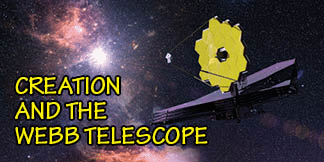
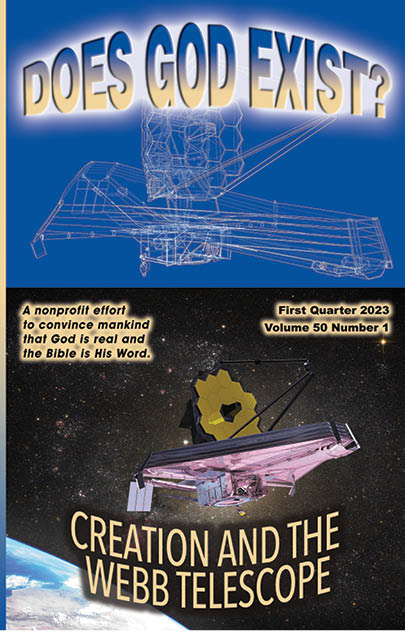
On Christmas day in 2021, an incredible telescope was launched into space. It weighed 13,580 pounds (6,160 kg) and cost US$10 billion. The justification for such an expensive project is that with it, we could see farther into space with better resolution than ever before. For example, one of the first pictures captured by the James Webb Space Telescope (JWST) was of the so-called “Pillars of Creation,” a feature of the Eagle Nebula 7,000 light years from Earth. This image revealed never-before-seen details of that nebula. The magnificent JWST will allow us to learn more about the real creation by peering many light years into the past.
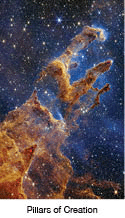
This telescope provides two extraordinary things. The first is its light-gathering ability. Because it is above Earth’s atmosphere and has a very large receiving surface, it can gather more light than other telescopes. At its location in space, the JWST is relatively unaffected by gravitational forces so that time exposures can be very long. The second is its resolving power, which is the ability of a lens system to separate point sources of light. For example, suppose you had a car facing out toward a lake with both headlights turned on. Poor resolving power would cause an observer across the lake to see just one light. Good resolving power would see both headlights. Early earth-based telescopes looked at what we now know as the Andromeda galaxy and saw a “fuzzy light.” Later telescopes were larger and had better resolving power, enabling astronomers to see that fuzzy light was actually billions of stars. The Webb telescope can look at Andromeda and see that there are planets going around many of the stars, something Earth based telescopes could never see.

How can the Webb telescope “see into the past?” This confusing statement is true because light travels at a fixed speed of approximately 186,000 miles (300,000 km) per second. Even at that speed, it takes a long time for it to travel across the distances in space. Light from the Sun takes eight minutes and 20 seconds to reach Earth. When you look at the sunrise or sunset, you are seeing the Sun as it was eight minutes and 20 seconds ago. If the Sun suddenly died, it would be eight minutes and 20 seconds before we would know it here on Earth.
We measure space distances in light years, which is the distance light can travel in one year — 5,878,625,373,200 miles (9,460,730,472,581 km). The North Star (Polaris) is 323 light years away, so we see it as it was 323 years ago. The Webb telescope can see objects that are 13 billion light-years away. That means we are seeing light that left those objects 13 billion years ago, and doubtless they have changed or gone out of existence since then. The Webb telescope can see objects within a span between 8 and 9 light-years wide (for astronomy students, that is 15,000 pixels).
It is essential to understand that JWST can see those objects, but how they got there is not a subject the Webb Telescope is designed to answer. Real creation is the production of matter from nothing. The Bible makes it clear that this happened from a dimension outside of space and time. The concept of acting outside of space and time describes God and agrees with the simple statement of Genesis 1:1. Quantum mechanics and the newest understandings of modern physics show more and more evidence that this is how creation came about, but that has nothing to do with what the Webb telescope is seeing.
So what does the Webb Telescope tell us? What are the real “pillars of creation,” and what do they tell us about the processes God used to produce the world where we live? Because of its excellent resolving power, the Webb Telescope shows us cocoons of dust collapsing under the forces of gravity. As those cocoons collapse, they heat up, and the Webb Telescope can measure the temperatures to verify the temperature rise. When the cocoon gets small enough and hot enough, the materials in the cocoon, mostly hydrogen, fuse into heavier elements, and a star is born. The Webb Telescope shows us the making of stars, not the creation of stars. God created the material from which stars are made long before the fusion process began.
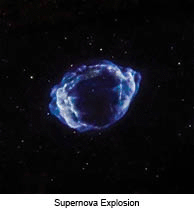
Smaller telescopes have enabled us to see the death of stars. When a star runs out of fuel, nuclear processes produce a change in stellar material. Different stars change the nuclear process in different ways. A nova is an explosion of a star, but there are several different kinds of explosions depending on the star's mass. These processes produce the other elements we see in the periodic chart of chemistry. Colossal explosions in super-massive stars called supernovas produce heavy elements like uranium, lead, and gold. Lighter elements such as carbon, sulfur, oxygen, potassium, sodium, etc., are produced in less massive stars.
The cosmos is not a dead creation that God wound up and let go to die. It is a living, dynamic thing that continues to grow, expand, and change. God is still active and continually working to sustain his creation as the elements are recycled and reworked. Black holes provide waste receptacles to dispose of finished matter. The Webb Telescope allows us to see the continual process of new materials being produced. This is the way God works. Life itself is constantly changing, and biology is another dynamic field where we can watch the design and processing of life, allowing life to survive in every nook and cranny of our planet.
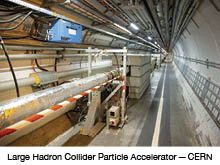
Between the Webb Telescope and massive nuclear accelerators, we continually gain more understanding of what God has done and how the creation has come to be as it is. The complexity we see and the incredible power and wisdom it displays speak of God. In Proverbs 8:1–5; 22–23, Wisdom speaks to all people about creation, and this is what she says about creation and God:
Does not wisdom call out? Does not understanding raise her voice? At the highest point along the way, where the paths meet, she takes her stand; beside the gate leading into the city, at the entrance, she cries aloud: “To you, O people, I call out; I raise my voice to all mankind. You who are simple, gain prudence; you who are foolish, set your hearts on it. … “The Lord brought me forth as the first of his works, before his deeds of old; I was formed long ages ago, at the very beginning, when the world came to be.

What a wonderful thing it is to be living in 2023 when we have tools that enable us to see this wisdom firsthand. To the ancients who did not have the tools, the simple statement “In the beginning, God created the heavens and the earth” was enough. We now can say with greater understanding, “The heavens declare the glory of God; and the skies proclaim the work of his hands” (Psalm 19:1).
Picture credits:
© alejomiranda. Image from big stock.com
Cover: top photo: © cherezoff; bottom photo: © alejomiranda. Images from big stock.com
Science - NASA, ESA, CSA, STScI, NIRCam - Processing - Joseph DePasquale (STScI), Anton M. Koekemoer (STScI), Alyssa Pagan (STScI).
© everest comunity. Image from big stock.com
NASA/CXC/CfA/S. Chakraborti et al.
© Belish. Image from big stock.com
© Dzmitry Dzemidovich. Image from big stock.com
Scripture links/references are from BibleGateway.com. Unhighlighted scriptures can be looked up at their website.
